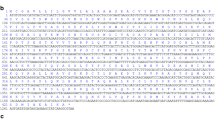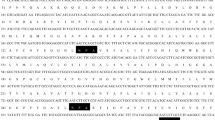Abstract
The α-carbonic anhydrase (α-CA) is a zinc ion-containing enzyme that catalyzes the hydration of carbon dioxide. In this paper, a full-length α-CA gene was cloned from Chlamydomonas sp. ICE-L using RT-PCR and RACE-PCR for bioinformatic analysis. The α-CA open reading frame obtained by PCR was cloned into a vector and transformed into Escherichia coli to generate α-CA-producing bacteria. The α-CA was highly expressed upon induction with isopropyl-β-d-thiogalactoside (IPTG) at a final concentration of 0.8 mM. A single band with a molecular weight of approximate 40 kDa expressed in the recombinant E. coli strain harboring the α-CA vector was observed in SDS-PAGE analysis. The carbon dioxide hydration activity and esterase activity of α-CA expressed by the recombinant strain were 0.404 U/mg and 0.319 U, respectively. In addition, three conditions, temperature, salinity and UVB radiation exposure, were selected to analyze α-CA transcription levels by qRT-PCR. The results suggested UVB exposure increased the expression of relative mRNA; meanwhile, the α-CA mRNA expression was rapidly induced by temperature and salinity stress, indicating that Chlamydomonas sp. ICE-L might modulate the α-CA mRNA expression to adapt to the extreme environments.







Similar content being viewed by others
References
An, M. L., Mou, S. L., Zhang, X. W., Ye, N. H., Zheng, Z., Cao, S. N., et al. (2013). Temperature regulates fatty acid desaturases at a transcriptional level and modulates the fatty acid profile in the Antarctic microalga Chlamydomonas sp. ICE-L. Bioresource Technology, 134, 151–157.
Bertucci, A., Tambutté, S., Supuran, C. T., Allemand, D., & Zoccola, D. (2011). A new coral carbonic anhydrase in Stylophora pistillata. Marine Biotechnology, 13, 992–1002.
Badger, M. R., & Price, G. D. (1994). The role of carbonic anhydrase in photosynthesis. Annual Review of Plant Physiology and Plant Molecular Biology, 45, 369–392.
Benlloch, R., Shevela, D., Hainzl, T., Grundström, C., Shutova, T., Messinger, J., et al. (2015). Crystal structure and functional characterization of photosystem II-associated carbonic anhydrase CAH3 in Chlamydomonas reinhardtii. Physiologia Plantarum, 167(3), 950–962.
Bhakta, A., Bandyopadhyay, M., Dasgupta, S., Sen, S., Kumar, A., & Biswas, U. K. (2016). Effect of NaHS on carbonic anhydrase activity of human erythrocyte. Asian Journal of Medical Sciences, 7, 23–27.
Capasso, C., & Supuran, C. T. (2015). An overview of the alpha-, beta- and gamma-carbonic anhydrases from Bacteria: can bacterial carbonic anhydrases shed new light on evolution of bacteria? Journal of Enzyme Inhibition and Medicinal Chemistry, 30(2), 325–332.
Capasso, C., & Supuran, C. T. (2015). Bacterial, fungal and protozoan carbonic anhydrases as drug targets. Expert Opinion on Therapeutic Targets, 19(12), 1689–1704.
Chegwidden, W. R., Carter, N. D., & Edwards, Y. H. (2000). The carbonic anhydrases: New horizons. Basel: Birkhauser.
Chen, C. S., Dai, Z. Z., Xu, Y., Ji, D. H., & Xie, C. T. (2016). Cloning, expression, and characterization of carbonic anhydrase genes from Pyropia haitanensis (Bangiales, Rhodophyta). Journal of Applied Phycology, 28(2), 1403–1417.
Darabi, M., & Seddigh, S. (2015). Bioinformatic characterization of aspartic protease (AP) enzyme in seed plants. Plant Systematics and Evolution, 301(10), 2399–2417.
Ding, Y., Miao, J. L., Wang, Q. F., Zheng, Z., Li, G. Y., Jian, J. C., et al. (2008). Purification and characterization of a psychrophilic glutathione reductase from Antarctic ice microalgae Chlamydomonas sp. Strain ICE-L. Polar Biology, 31, 23–30.
Fujiwara, S., Fukuzawa, H., Tachiki, A., & Miyachi, S. (1990). Structure and differential expression of two genes encoding carbonic anhydrase in Chlamydomonas reinhardtii. Proceedings of the National Academy of Sciences, 87(24), 9779–9783.
Gao, K. S., & Zheng, Y. Q. (2010). Combined effects of ocean acidification and solar UV radiation on photosynthesis, growth, pigmentation and calcification of the coralline alga Corallina sessilis (Rhodophyta). Global Change Biology, 16, 2388–2398.
Hille, R. V., Fagan, M., Bromfield, L., & Pott, R. (2014). A modified pH drift assay for inorganic carbon accumulation and external carbonic anhydrase activity in microalgae. Journal of Applied Phycology, 26(1), 377–385.
Hou, J. W., Ji, C., Dong, G. X., Xiao, B. W., Ye, Y., & Chen, V. (2015). Biocatalytic Janus membranes for CO2 removal utilizing carbonic anhydrase. Journal of Materials Chemistry A, 3, 17032–17041.
Li, G., & Gao, K. S. (2014). Effects of solar UV radiation on photosynthetic performance of the diatom Skeletonema costatum grown under nitrate limited condition. Algae, 29, 27–34.
Livak, K. J., & Schmittgen, T. D. (2001). Analysis of relative gene expression data using real-time quantitative PCR and PCR and the 2−∆∆CT method. Method, 25, 402–408.
Luca, V. D., Vullo, D., Prete, S. D., Carginale, V., et al. (2016). Cloning, characterization and anion inhibition studies of a γ-carbonic anhydrase from the Antarctic bacterium Colwellia psychrerythraea. Bioorganic & Medicinal Chemistry, 24(4), 835–840.
Meldrum, Nu, & Roughton, F. J. (1933). Carbonic anhydrase: its preparation and properties. Journal of Physiology, 80(2), 113–142.
Moroney, J. V., Bartlett, S. G., & Samuelsson, G. (2001). Carbonic anhydrases in plants and algae. Plant, Cell and Environment, 24(2), 141–153.
Polo, L. K., Felix, M. R. L., Kreusch, M., Pereira, D. T., Costa, G. B., Simioni, C., et al. (2015). Metabolic profile of the brown macroalga Sargassum cymosum (Phaeophyceae, Fucales) under laboratory UV radiation and salinity conditions. Journal of Applied Phycology, 27, 887–899.
Pongsomboon, S., Udomlertpreecha, S., Amparyup, P., Wuthisuthimethavee, S., & Tassanakajon, A. (2009). Gene expression and activity of carbonic anhydrase in salinity stressed Penaeus monodon. Comparative Biochemistry and Physiology, 152(2), 225–233.
Provasoli, L. (1968). Media and prospects for the cultivation of marine algae. Japanese Society for Plant Physiology, 63–75.
Rautenberger, R., & Kai, B. (2006). Impact of temperature on UV-susceptibility of two Ulva (Chlorophyta) species from Antarctic and Subantarctic regions. Polar Biology, 29, 988–996.
Rech, M., Mouget, J. L., Morant-Manceau, A., Rosa, P., & Tremblin, G. (2005). Long-term acclimation to UV radiation: effects on growth, photosynthesis and carbonic anhydrase activity in marine diatoms. Botanica Marina, 48(5), 407–420.
Regoli, F., Nigro, M., Bertoli, E., & PrincipatoG, Orlando E. (1997). Defenses against oxidative stress in the Antarctic scallop Adamussiumcolbecki and effects of acute exposure to metals. Hydrobiologia, 355, 139–144.
Rudenko, N. N., Ignatova, L. K., Fedorchuk, T. P., & Ivanov, B. N. (2015). Carbonic anhydrases in photosynthetic cells of higher plants. Biochemistry, 80(6), 674–687.
Scholz, B., Rúa, A., & Liebezeit, G. (2014). Effects of UV radiation on five marine microphytobenthic Wadden sea diatoms, isolated from the Solthörn tidal flat (Lower Saxony, southern North Sea)–Part II: Changes in carbohydrate, amino acid and fatty acid composition. European Journal of Phycology, 49, 97–114.
Shutova, T., Kenneweg, H., Buchta, J., Nikitina, J., Terentyev, V., Chernyshov, S., et al. (2008). The photosystem II-associated Cah3 in Chlamydomonas enhances the O2 evolution rate by proton removal. European Molecular Biology Organization, 27, 782–791.
Simone, G. D., Monti, S. M., Alterio, V., Buonanno, M., Luca, V. D., Rossi, M., et al. (2015). Bioorganic & Medicinal Chemistry Letters, 25(9), 2002–2006.
Simone, G. D., & Supuran, C. T. (2012). (In)organic anions as carbonic anhydrase inhibitors. Journal of Inorganic Biochemistry, 111, 117–129.
Sinetova, M. A., Kupriyanova, E. V., Markelova, A. G., Allakhverdiev, S. I., & Pronina, N. A. (2012). Identification and functional role of the carbonic anhydrase Cah3 in thylakoid membranes of pyrenoid of Chlamydomonas reinhardtii. Biochimica et Biophysica Acta—Bioenergetics, 1817, 1248–1255.
Supuran, C. T., & Capasso, C. (2015). The η-class carbonic anhydrases as drug targets for antimalarial agents. Expert Opinion on Therapeutic Targets, 19(4), 551–563.
Suzuki, K., Yang, S. Y., Shimizu, S., Morishita, E. C., Jiang, J., Zhang, F., et al. (2011). The unique structure of carbonic anhydrase αCA1 from Chlamydomonas reinhardtii. Biological Crystallography, 67, 894–901.
Syrjänen, L., Tolvanen, M., Hilvo, M., Vullo, D., Carta, F., Supuran, C. T., et al. (2013). Characterization, bioinformatic analysis and dithiocarbamate inhibition studies of two new α-carbonic anhydrases, CAH1 and CAH2, from the fruit fly Drosophila melanogaster. Bioorganic & Medicinal Chemistry, 21(6), 1516–1521.
Thompson, J. D., Gibson, T. J., Plewniak, F., Jeanmougin, F., & Higgins, D. G. (1997). The CLUSTAL_X windows interface: flexible strategies for multiple sequence alignment aided by quality analysis tools. Nucleic Acids Research, 25, 4876–4882.
Tripp, B. C., Smith, K., & Ferry, J. G. (2001). Carbonic anhydrase: new insights for an ancient enzyme. The Journal of biological chemistry, 276(52), 48615–48618.
Wang, Q. F., Hou, Y. H., Miao, J. L., & Li, G. Y. (2009). Effect of UV-B radiation on the growth and antioxidant enzymes of Antarctic sea ice microalgae Chlamydomonas sp. ICE-L. Acta Physiologiae Plantarum, 31, 1097–1102.
Yang, N., Peng, C. L., Cheng, D., Huang, Q., Xu, G. H., Gao, F., et al. (2013). The over-expression of calmodulin from Antarctic notothenioid fish increases cold tolerance in tobacco. Gene, 521, 32–37.
Zeng, Y. L., Zhang, H. B., Lan, H. Y., & Zhang, F. C. (2008). Cloning of BhNHX gene from betula halophila and its co-expressional regulation with CaM gene under different stresses. Acta Botanica Boreali-Occidentalia Sinica, 28, 2408–2415.
Acknowledgements
This work was funded by Natural Science Foundation of China (No. 41576187), Basic Scientific Fund for National Public Research Institutes of China (No. 2016Q10), Postdoctoral Applied Research Projects of Qingdao (No. QDBSH2015015), Key Research and Development Program of Shandong Province (Nos. 2016YYSP017, 2016ZDJS06A03, 2017GHY15112), Natural Science Foundation of China-Shandong Joint Fund (No. U1606403), Public Science and Technology Research Funds Projects of Ocean (No. 201405015), Qingdao Entrepreneurship and Innovation Pioneers Program (No. 15-10-3-15-(44)-zch), Shandong Provincial Natural Science Foundation (No. ZR2017QD008), and Polar Strategic Foundation of China (No. 20150303).
Author information
Authors and Affiliations
Corresponding author
Rights and permissions
About this article
Cite this article
Qu, C., He, Y., Zheng, Z. et al. Cloning, Expression Analysis and Enzyme Activity Assays of the α-Carbonic Anhydrase Gene from Chlamydomonas sp. ICE-L. Mol Biotechnol 60, 21–30 (2018). https://doi.org/10.1007/s12033-017-0040-9
Published:
Issue Date:
DOI: https://doi.org/10.1007/s12033-017-0040-9




